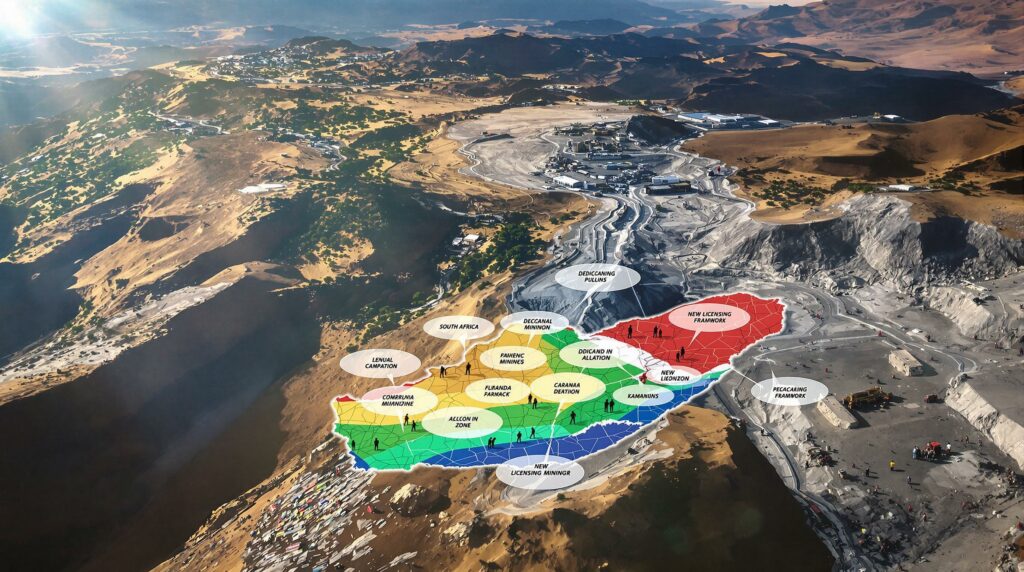South Africa's New Artisanal Mining Framework: Creating Economic Opportunity Through Formalization
South Africa has taken a significant step toward inclusive economic growth with the introduction of a comprehensive licensing framework for artisanal and small-scale mining operations. The framework, outlined in corrections to the Draft Mineral Resources Development Bill 2025, aims to transform previously unregulated mining activities into formalized, community-driven economic opportunities.
This regulatory innovation represents a strategic shift in South Africa's approach to resource governance, particularly for communities historically excluded from the benefits of mining activities in their regions.
What is South Africa's New Artisanal Mining Licensing System?
The new artisanal mining licensing framework establishes a structured approach to small-scale mining that had previously existed in regulatory limbo. Through designated mining zones, streamlined mining permit process, and specific eligibility requirements, the system creates legitimate pathways for community-based organizations to participate in the mining economy.
Minister Gwede Mantashe emphasized that the framework would "ensure regulatory certainty while promoting local industrialization, employment and skills development in mining-affected areas," highlighting the government's commitment to both economic development and regulatory compliance.
The licensing system includes several key components designed to balance accessibility with appropriate oversight:
- Formalization of previously unregulated mining activities through clear legal pathways
- Establishment of designated artisanal mining zones with specific operational parameters
- Streamlined permit application processes with reduced bureaucratic barriers
- Special eligibility criteria prioritizing community-based organizations
- Integration into current mineral resources legislation to ensure consistency
Historical Context of Artisanal Mining Regulation
The current framework builds upon earlier efforts to address artisanal mining's place in South Africa's mineral economy. Initially proposed in the unimplemented 2020 Mineral and Petroleum Resources Development Act (MPRDA) amendment, the concept has now been fully integrated into current legislation.
This evolution represents a significant shift in resource governance philosophy, moving from viewing artisanal mining primarily as an enforcement challenge to recognizing its potential as a vehicle for inclusive economic participation. This approach acknowledges historical inequities in mineral resource access while creating structured pathways to formalization.
The framework's implementation comes after years of debate about how best to address informal mining activities—balancing legitimate economic opportunities against concerns about safety, environmental impact, and mineral resource management.
How Will the Artisanal Mining Framework Benefit Local Communities?
The licensing system has been specifically designed to create economic opportunities for communities that have historically been excluded from mining benefits, despite often living directly above valuable mineral deposits.
Economic Inclusion Opportunities
By creating accessible entry points to the formal mining economy, the framework offers several potential community benefits:
- Direct participation in the mining sector for marginalized communities previously excluded
- Low-capital entry points for community-based mining enterprises with limited financial resources
- Potential employment opportunities for workers displaced from traditional export industries
- Stimulation of regional economic development in mining-affected areas
- Creation of localized supply chains supporting community businesses
Officials have emphasized that the measures target "inclusive economic growth and address historical inequities in mineral resource access," representing a commitment to more equitable distribution of the country's mineral wealth.
Community Empowerment Mechanisms
Beyond economic access, the framework incorporates specific mechanisms designed to empower local communities:
- Preferential access to designated mining zones for organizations from mining-affected areas
- Skills development programs designed specifically for artisanal miners
- Support for local industrialization initiatives tied to mining activities
- Reduced barriers to entry for community-based mining ventures
- Opportunities for knowledge transfer and capacity building
These mechanisms acknowledge that successful community participation requires more than mere legal permission—it necessitates supporting infrastructure, skills development, and preferential access policies that address historical imbalances.
Important Consideration: While the framework creates legitimate opportunities, communities will need significant support in areas including technical training, safety standards, environmental management, and business development to fully realize these benefits.
What Are the Strategic Implications for South Africa's Mining Sector?
The introduction of this licensing framework comes at a strategically significant time for South Africa's mining industry, particularly given recent international trade challenges.
Response to International Trade Pressures
The artisanal mining framework represents a potential buffer against external economic pressures, including:
- Alternative employment avenues for workers potentially affected by 30% tariffs on selected South African exports to the US
- Reduced vulnerability to external trade shocks through diversification of the mining sector
- Creation of domestic market opportunities less susceptible to international market volatility
- Alignment with African Continental Free Trade Area commitments emphasizing intra-African trade
This timing suggests the framework may serve both domestic economic development goals and strategic trade interests—providing alternative economic pathways during a period of international trade uncertainty.
Domestic Economic Resilience Building
Beyond responding to immediate trade concerns, the framework contributes to longer-term economic resilience through:
- Shifting toward domestic-focused growth strategies less dependent on international markets
- Emphasizing local SA mineral beneficiation rather than raw material export
- Reducing dependence on Global North markets for economic sustainability
- Developing community-based economic structures with greater stability during global market fluctuations
- Creating diversified mining activities across different scales and methods
The framework's focus on community-based mining represents a strategic diversification of South Africa's mining sector—balancing large-scale industrial mining with smaller, more locally embedded operations.
What Regulatory Changes Accompany the Artisanal Mining Framework?
Beyond the artisanal mining provisions, the Draft Mineral Resources Development Bill 2025 introduces additional regulatory measures affecting the broader mining sector.
Enhanced Ministerial Oversight
The bill significantly strengthens governmental supervision of mining operations through:
- Written consent requirement for any cession or transfer of mining rights
- Stricter controls on prospecting right transfers between entities
- Increased governmental supervision of mining operations across all scales
- Strengthened compliance mechanisms ensuring adherence to licensing conditions
- Greater ministerial authority in determining appropriate resource utilization
These measures represent a more interventionist approach to mining governance, with greater emphasis on ensuring mining activities align with national development objectives.
Regulatory Certainty Initiatives
To support effective implementation, the framework includes several provisions designed to create greater clarity and certainty:
- Clarification of previously ambiguous mining regulations regarding small-scale operations
- Standardization of artisanal mining operational requirements across regions
- Establishment of clear eligibility criteria for participation in the licensing system
- Creation of designated mining zones with specific governance structures
- Development of appropriate environmental management requirements scaled to operation size
These regulatory certainty initiatives aim to create a transparent, predictable operating environment—essential for both community-based organizations and regulatory authorities to effectively navigate the new system.
How Will the New Licensing System Be Implemented?
The successful implementation of the artisanal mining licensing framework depends on several key processes and timelines.
Implementation Timeline
The framework will follow a structured implementation process:
- Public consultation period ending August 13, 2025
- Subsequent cabinet approval process reviewing public input
- Parliamentary review and potential amendments to address concerns
- Presidential enactment within approximately one year of initial proposal
- Development of supporting regulations and operational guidelines
This timeline suggests the framework could be operational by late 2026, though full implementation including supporting regulations may extend beyond this date.
Cross-Departmental Coordination Requirements
Effective implementation will require significant coordination across multiple government entities:
- Inter-ministerial collaboration between minerals, environment, labor, and community development departments
- Local government involvement in designated zone management and community engagement
- Environmental authority participation in sustainability oversight and compliance monitoring
- Skills development coordination with educational institutions and training providers
- Law enforcement collaboration to distinguish between legitimate artisanal operations and illegal mining
This cross-departmental coordination represents one of the framework's most significant implementation challenges, requiring alignment of different regulatory approaches and departmental priorities.
What Challenges Might Affect the Licensing System's Success?
Despite its potential benefits, the artisanal mining licensing framework faces several implementation challenges that could affect its ultimate success.
Potential Implementation Hurdles
Several practical challenges could impact effective implementation:
- Need for comprehensive supporting regulations detailing operational requirements
- Requirements for effective inter-departmental coordination across multiple agencies
- Potential resistance from established mining interests concerned about resource competition
- Enforcement challenges in remote mining areas with limited governmental presence
- Environmental management considerations balancing accessibility with sustainability
- Technical capacity limitations among potential community participants
These implementation hurdles highlight the gap between policy development and practical execution—requiring sustained commitment and resource allocation to overcome.
Balancing Competing Interests
The framework must navigate several competing stakeholder interests:
- Formal mining sector concerns about resource competition and operational conflicts
- Environmental protection imperatives versus economic opportunity creation
- Regulatory oversight requirements versus operational flexibility for small-scale miners
- National versus local governance priorities regarding resource utilization
- Short-term implementation demands versus long-term sustainability objectives
Successfully balancing these competing interests will require ongoing stakeholder engagement and adaptive management approaches as the framework moves from concept to implementation. Furthermore, lessons learned from Namibia mining halt situations could inform better implementation strategies.
How Does the Framework Address Illegal Mining Concerns?
The formalization of artisanal mining through this licensing system represents a significant shift in South Africa's approach to addressing illegal mining activities.
From Criminalization to Formalization
The framework creates a pathway from illegality to legitimacy through:
- Transition options for previously illegal miners to enter the formal economy
- Regulatory structure establishing clear parameters for legitimate artisanal operations
- Clearer distinction between criminal mining activities and informal economic participation
- Potential reduction in mining-related criminal activities through legitimate alternatives
- Creation of community-based monitoring and compliance mechanisms
This approach recognizes that purely enforcement-based strategies have proven ineffective at addressing informal mining—offering formalization as an alternative pathway to achieve both compliance and economic development goals.
Enforcement Mechanisms
While creating legitimate pathways, the framework also strengthens the ability to address truly illegal operations:
- Designated zones with specific operational parameters creating clear boundaries of legitimacy
- Clear distinction between licensed and unlicensed operations for enforcement purposes
- Potential for more targeted enforcement against criminal elements once legitimate operators are formalized
- Community involvement in compliance monitoring and reporting
- Creation of market channels exclusively for legally mined materials
These dual approaches—creating legitimate pathways while strengthening enforcement against criminal activities—represent a more sophisticated approach to the complex challenge of illegal mining. As highlighted by UCT Mineral Law experts, the regulatory framework strikes a balance between control and opportunity.
Disclaimer: The success of this formalization approach depends on effective implementation, adequate resources for both support and enforcement, and realistic pathways for current informal miners to transition to legitimate operations.
FAQ: South Africa's Artisanal Mining Licensing System
Who is eligible to apply for artisanal mining licenses?
The licensing framework prioritizes community-based organizations and individuals from historically disadvantaged backgrounds, particularly those from mining-affected communities. While specific eligibility criteria will be detailed in supporting regulations, the system is designed to create accessible entry points for communities previously excluded from formal mining activities.
What minerals can be mined under artisanal licenses?
While specific mineral restrictions will be detailed in supporting regulations, the framework likely focuses on easily accessible surface deposits suitable for low-technology mining methods. This may include certain precious metals, gemstones, and industrial minerals that can be extracted safely using artisanal techniques.
How does the new system differ from previous mining regulations?
The new framework creates a distinct regulatory category for small-scale operations with simplified procedures, lower capital requirements, and community-focused eligibility criteria. Unlike previous regulations designed primarily for large-scale operations, this system acknowledges the different operational realities of artisanal mining while maintaining appropriate oversight.
What environmental safeguards are included in the licensing system?
The framework includes basic environmental management requirements appropriate to the scale of operations, though detailed environmental provisions will be specified in forthcoming regulations. These are likely to include restrictions on certain processing techniques, requirements for site rehabilitation, and prohibitions on mining in environmentally sensitive areas. Recent advances in mine reclamation innovation may inform these requirements.
When will the licensing system become fully operational?
Following the public consultation period ending August 13, 2025, the bill will proceed through cabinet approval and parliamentary review, with potential implementation within the next year. However, full operationalization will depend on the development of supporting regulations, which may extend the timeline into late 2026 or beyond.
Further Exploration
This framework represents a significant evolution in South Africa's approach to mining governance, balancing economic opportunity with appropriate regulatory oversight. As implementation proceeds, continued stakeholder engagement will be essential to refine the system and address emerging challenges.
The success of this initiative will ultimately be measured by its ability to create genuine economic opportunities for mining-affected communities while ensuring operations meet appropriate safety, environmental, and governance standards. Additionally, the framework may serve as a model for how mining industry innovation can create more inclusive economic structures.
Want to Stay Ahead of the Next Major Mineral Discovery?
Discovery Alert's proprietary Discovery IQ model instantly notifies investors of significant ASX mineral discoveries, transforming complex data into actionable insights for immediate market advantage. Explore historic discoveries and their exceptional returns by visiting the dedicated discoveries page and begin your 30-day free trial today.




